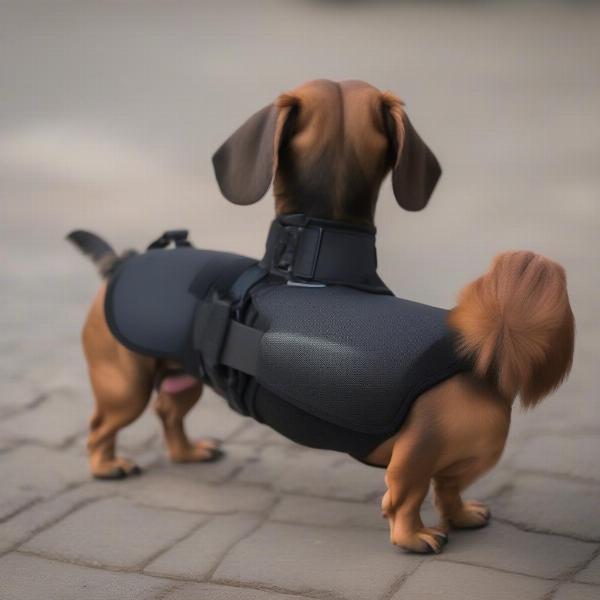Weiner dogs, also known as Dachshunds, are adorable with their long bodies and short legs. However, their unique physique predisposes them to back problems, often requiring a weiner dog back brace. This guide explores everything you need to know about weiner dog back braces, from understanding why they’re necessary to choosing the right one and ensuring its proper use.
Why Do Weiner Dogs Need Back Braces?
Dachshunds are prone to Intervertebral Disc Disease (IVDD), a condition affecting the spinal discs. Their elongated spines put extra pressure on these discs, making them susceptible to herniation or rupture. This can cause pain, weakness, and even paralysis. A weiner dog back brace helps support their spine, reducing pressure on the discs and alleviating discomfort.
 Dachshund with IVDD preventative brace
Dachshund with IVDD preventative brace
Understanding IVDD and its Symptoms
IVDD can manifest in various ways, from mild discomfort to severe pain and neurological issues. Common symptoms include reluctance to jump or climb stairs, hunched posture, yelping when touched, and difficulty walking. If your weiner dog displays any of these signs, consult a veterinarian immediately.
Choosing the Right Weiner Dog Back Brace
Not all back braces are created equal. Selecting the correct brace for your weiner dog depends on the severity of their condition and their individual needs.
Types of Weiner Dog Back Braces
- Soft Braces: Offer mild support and compression, ideal for dogs with early-stage IVDD or for preventative use. weiner dog backpack might be a suitable alternative for very mild cases.
- Rigid Braces: Provide more substantial support and stabilization, suitable for dogs with moderate to severe IVDD.
- Custom Braces: Designed specifically for your dog’s measurements, offering the best fit and support.
Factors to Consider When Choosing a Brace
- Size and Fit: Ensure the brace fits snugly but not too tight, allowing for comfortable movement and breathing.
- Material: Choose a breathable, durable material that is easy to clean.
- Support Level: Select the appropriate level of support based on your veterinarian’s recommendations.
- Ease of Use: Opt for a brace that is easy to put on and take off.
Using and Caring for Your Weiner Dog Back Brace
Proper use and care are essential for maximizing the effectiveness of the brace and preventing further injury.
How to Put on a Weiner Dog Back Brace
Follow the manufacturer’s instructions carefully. Generally, the brace should be positioned to support the spine from the neck to the base of the tail. Ensure it is snug but not restrictive.
Cleaning and Maintenance
Regularly clean the brace according to the manufacturer’s instructions. Most braces can be hand-washed with mild soap and water. Allow the brace to air dry completely before putting it back on your dog.
Living with a Weiner Dog in a Back Brace
A back brace can significantly improve your weiner dog’s quality of life, allowing them to move more comfortably and participate in activities they enjoy. However, it’s important to make some adjustments to their lifestyle.
Exercise and Activity
While a brace provides support, it’s crucial to avoid strenuous activities that could exacerbate their condition. Short, gentle walks on a leash are generally recommended. Avoid activities like jumping, running, and rough play. spot the dog costume might be fun, but ensure it doesn’t interfere with the brace.
Monitoring and Follow-up
Regular veterinary check-ups are crucial to monitor your dog’s progress and adjust treatment as needed. Observe your dog closely for any signs of discomfort or changes in their condition.
Conclusion
A weiner dog back brace can be a valuable tool in managing IVDD and improving your furry friend’s comfort and mobility. By understanding the different types of braces available, choosing the right one for your dog’s needs, and using it correctly, you can help them live a happy and active life. weiner dog christmas will be even more enjoyable with a comfortable pup!
FAQ
- How long does a weiner dog need to wear a back brace? The duration varies depending on the severity of their condition. Your veterinarian will recommend the appropriate timeframe.
- Can a back brace cure IVDD? While a brace can help manage symptoms and prevent further injury, it doesn’t cure IVDD.
- Are there any alternatives to back braces? Other treatment options include medication, physical therapy, and surgery. Your veterinarian can discuss the best course of action for your dog.
- Can my weiner dog sleep in their back brace? It depends on the type of brace and your veterinarian’s recommendations. Some braces are designed for continuous wear, while others should be removed at night.
- How do I know if the brace is fitting correctly? The brace should be snug but not restrict movement or breathing. You should be able to fit two fingers comfortably between the brace and your dog’s skin.
- Can a back brace prevent IVDD? While a brace can offer support and reduce strain on the spine, it cannot completely prevent IVDD. However, it can be helpful for dogs with a genetic predisposition to the condition.
- What are the signs that the brace isn’t working? If your dog shows increased discomfort, reluctance to move, or worsening of neurological symptoms, consult your veterinarian.
ILM Dog is your trusted partner in providing comprehensive resources for all aspects of dog care, from breed selection to senior dog care. We strive to equip dog owners worldwide with the knowledge and resources needed to raise happy and healthy canine companions. We specialize in offering practical advice on health and medical care, training and behavior, nutrition, grooming, exercise, and product recommendations. For further assistance and personalized advice, reach out to our experts via email at [email protected] or call us at +44 20-3965-8624. ILM Dog is here to support you every step of the way on your dog ownership journey.